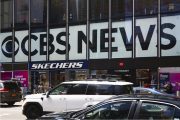It’s called the breakdown of civil society. It’s also called something else:
Having good people subsidize thieving miscreants through higher costs of goods and services.
Call it the Lowlife Tax.
Or the Irresponsibility Tax.
Or, perhaps even more fittingly, the Electing the Wrong Politicians Tax.
(Winner, winner, chicken dinner?)
The latest example — of many — is an apparently organized robbery at a Memphis, Tennessee, intersection in which several cars blocked in a FedEx truck, after which dozens of criminals pillaged the semi’s packages. The New York Post has the rest of the story:
Video from the scene [below] shows multiple people running through parked cars in the road toward the FedEx truck as the driver attempts to escape the ravagers who are carrying their loot.
Multiple men allegedly used an unknown tool to open the safety latch on the truck’s sealed back doors and took numerous packages, the driver said, according to multiple local reports.
When police officers arrived, multiple vehicles were seen recklessly speeding away Saturday night, the Memphis Police Department said, according to Fox13 Memphis.
Unfortunately, the above reflects a new norm. Shoplifting has now reached profession status to the point where it often involves crime rings and has a name: Organized Retail Crime (ORC). It’s lucrative, too. As Business Insider (BI) reported less than a year ago:
Target is expecting to lose $600 million in profits because of it. Walgreens reported a 52% increase in it since 2019. And everyone from retailers to the federal government and law enforcement is trying [not hard enough, obviously] to stop it.
It’s organized retail crime, and it’s a nearly $100 billion problem for the industry.
These crimes aren’t as simple as a lone shoplifter pocketing a product. Instead, criminal organizations are stealing large quantities of goods and reselling them for profit.
In other words, this isn’t Jean Valjean in Les Misérables pilfering a loaf of bread to stave off starvation. These are greedy, wicked criminals with comfortable modern lives who leech off society.
“And the issue is growing,” BI also wrote. “A 2022 study the National Retail Federation conducted found that organized retail crime at retailers surged by 26.5% in 2021 compared to the year prior. Organized retail crime mainly drove inventory shrink — what happens when a store has fewer products on its shelves than recorded in its inventory — and resulted in $94.5 billion in losses for retailers last year, the NRF found.”
BI further informed that the proceeds from the online sales of these stolen goods “have been linked to other criminal enterprises like drugs and human trafficking.” (Note: Is it possible that the authorities would have more resources to devote to combating these actual crimes if they focused less on censoring the internet and punishing anti-establishment dissenters?)
We Consumers Foot the Bill
The consequences of this tolerated criminality are severe. As an example, “‘For every $330 worth of products stolen, a retailer has to sell an incremental $300,000 worth of goods to break even,’ said Burt Flickinger, managing director of retail consultancy Strategic Resource Group,” related CNN last year. “‘We’ve talked to retailers across America who say shoplifting is now 2% to 3% of their total sales.’”
Consumers pay the price, too. “Independent retail studies [from the 2002 National Retail Security Survey] have estimated theft from retail stores costs the American public 33.21 billion dollars per year,” reported Crime Doctor in 2020. That “equates to 1.0-1.2 million shoplift incidents every day at a loss rate of $19,000-$25,300 dollars stolen per minute,” the site later added.
What does this mean for us, specifically? Well, CNN cited a report finding that this theft cost “the average American family about $435” annually — in 2009 already. One can only imagine the price tag today.
Think about this when pondering recent times’ burgeoning prices: They partially reflect your subsidizing of criminals’ luxury. Something else should be pondered, too, when seeing headlines such as “Thieves in LA are looting freight trains filled with packages from UPS, FedEx and Amazon.” To wit:
This smacks of the Old West, with its stagecoach and train robberies. But aside from these 19th-century woes being exaggerated, there’s a difference:
Americans 170 years ago paid little to no taxes. We pay through the nose and yet, because there’s rampant criminality regardless, also have to pay the Electing the Wrong Politicians Tax.
As this implies, none of this extreme theft is inevitable. The remedy merely requires the administration of consequences sufficient to deter the crime. And two factors must be considered here:
- The actual punishment administered.
- The probability that a transgressor will be apprehended, prosecuted, and convicted.
I elaborated on this in 2008, writing:
This means that as punishment becomes less severe, the apprehension rate must increase to maintain a given deterrent. And one reason we don’t thwart crime as effectively as we could is that we forget the second factor when assessing risk…. This creates an economic calculus that favors the criminal.
For instance, it’s said that theft entails only a .6 percent chance of being caught and convicted; therefore, a thief has to commit an average of about 167 crimes before he will be incarcerated. Now, since the average sentence for theft is only about two months, this means a thief may serve an average of less than nine hours per robbery.
Translation: Crime now pays.
And because feckless politicians are never forced to pay sufficiently, at election time, this situation continues. That’s what residents in crime-ridden cities need to remember, too: The crime they’re financing, they also voted for.


